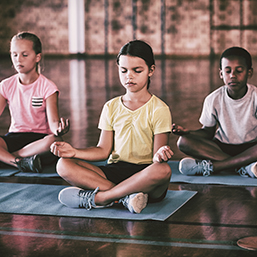
Many parents are seeking ways to help kids manage stress, build emotional awareness, and find balance. Movement isn’t just about staying active; it can be a powerful gateway to mindfulness and regulation.
\n \nThere are several options for programming in Calgary - including art classes, yoga, martial arts, music, and dance - to support children’s emotional resilience, focus, and well-being.
\nMindfulness research shows that movement-based interventions significantly improve behavioral regulation, executive function, and metacognition (considering one’s own thoughts) in children and adolescents.
\nPractices like yoga and expressive arts activate the body-and-mind connection, helping young people develop awareness of sensations and feelings, and learn to respond thoughtfully rather than react impulsively.
\nPrograms that combine physical (breath, body), social (group, intentional interaction), and cognitive (reflection, journaling or discussion) mindfulness support healthy emotional development, and there are many options to choose from in our city.
\nVisual Arts
\nAttending an art class can encourage an expressive outlet for big feelings, and the creative process helps kids regulate emotions, build patience, and experience joy in self-expression.
\nCreating art helps children reflect on their internal state. Choosing colors, shapes, or subjects can lead to self-discovery and emotional insight. Children can place emotions outside of themselves. For example, drawing a ‘worry monster’ helps in distancing from and managing distressing feelings.
\n“Art can be a great way for kids (and adults) to find their calm. When they draw or paint, they’re not just being creative – they’re also learning to focus, express themselves, and stick with something even when it’s challenging,” says Diana Didrikson, administrator and owner of Aliki's Art House.
\n“It helps them let go of perfectionism, work through problems, and build confidence along the way."
\nThe act of drawing, painting, or sculpting can be meditative, lowering cortisol (stress hormone) levels and inducing a state of calm. Completing an artwork can give children a sense of control and achievement, important for managing frustration and self-esteem.
\nYoga & Mindful Movement
\nYoga can be a powerful tool for helping children with emotional regulation: the ability to recognize, understand, and manage their emotions. Breath-focused practices (like pranayama) and mindfulness in yoga teach children to notice how they feel physically and emotionally.
\nYoga provides structured ways to calm the nervous system, such as deep breathing, gentle movements, and grounding poses.
\n“These practices give kids the space to slow down, check in with themselves, and build tools for calm and connection,” says Jenna Galloway, founder and CEO of Wymbin + Fledge Health.
\n“A recent longitudinal study we conducted with the University of Calgary reinforced what we’ve observed for years – that integrating these simple, embodied practices can make a measurable difference in children’s focus, self-regulation, and overall well-being.”
\nRegular yoga practice reduces stress hormones (like cortisol) and increases feel-good chemicals (like dopamine and serotonin). Children who practice yoga may become better at handling challenges, frustration, or disappointment.
\nGroup yoga builds empathy, patience, and communication skills, which support emotional understanding and regulation in social settings.
\nMartial Arts
\nMartial arts encourage physical discipline along with emotional awareness. These arts – like karate, taekwondo, and Brazilian jiu-jitsu – instill routines, rules, and respect for authority (instructors, classmates, and themselves). This structure helps children understand the consequences of their actions, practice self-control consistently in a safe setting, and develop patience, especially when they don't succeed immediately.
\nMartial arts provide a constructive way to release anger and frustration (through kicks, punches, or movement) and restlessness or anxiety (through repetitive drills and focus). Children who feel more in control of their bodies often feel more in control of their emotions. In addition, martial arts teach new skills that kids can be proud of and progressing through belt ranks provides a sense of achievement.
\nMusic
\nMusic can reflect and amplify feelings, helping children match their inner emotions and process them in a safe way. Listening to upbeat or soothing music can help shift a child’s mood from anxious or angry to calm and focused.
\n“Singing in choirs can be a powerful mechanism to help children regulate, express, and manage their emotions,” says Terry Clark, director of the Mount Royal University Conservatory.
\n“Singing helps children explore their feelings, can build emotional vocabulary, and develop strategies to cope with and manage a range of feelings they may experience.”
\nSinging within groups, such as choirs, can provide the added benefit of improved social skills. Because group singing is based upon social interaction with other children, it promotes cooperation and can give children a sense of belonging. Group singing has also been found to trigger the release of endorphins, which is a natural mood enhancer and reduces stress and anxiety.
\nDance
\nDance helps children regulate emotions by combining physical activity with expressive art, cognitive discipline, and social interaction.
\nBallet students develop focus, strength, spatial awareness, and elegance through disciplined training, but they’re also invited to improvise, play with props, and choose movement, building creativity alongside technique. This balanced approach helps children learn mindfulness through body awareness and movement intention.
\nAll forms of dance require focus, patience, and impulse control – skills that are directly related to emotional regulation. Dance demands concentration and presence, helping children practice mindfulness, which is strongly linked to emotional regulation. It also allows children to express complex emotions (joy, sadness, frustration) through movement, which is especially helpful for those who struggle with verbal expression.
\nMovement for mindfulness isn’t just about fitness – it’s a path to emotional resilience and self-awareness. Calgary parents don’t have to choose between physical activity and mental wellness; the city offers a rich variety of intentionally designed programs that help children find (and keep) their calm.
\nWhether you find a playful yoga class, a martial art rooted in breath, a choir that builds confidence, or art that expresses feeling, there’s something out there to help your child step into mindful, empowering movement. CCM
\n\n
See our related articles:
\nCalgary’s Child Magazine © 2025 Calgary’s Child